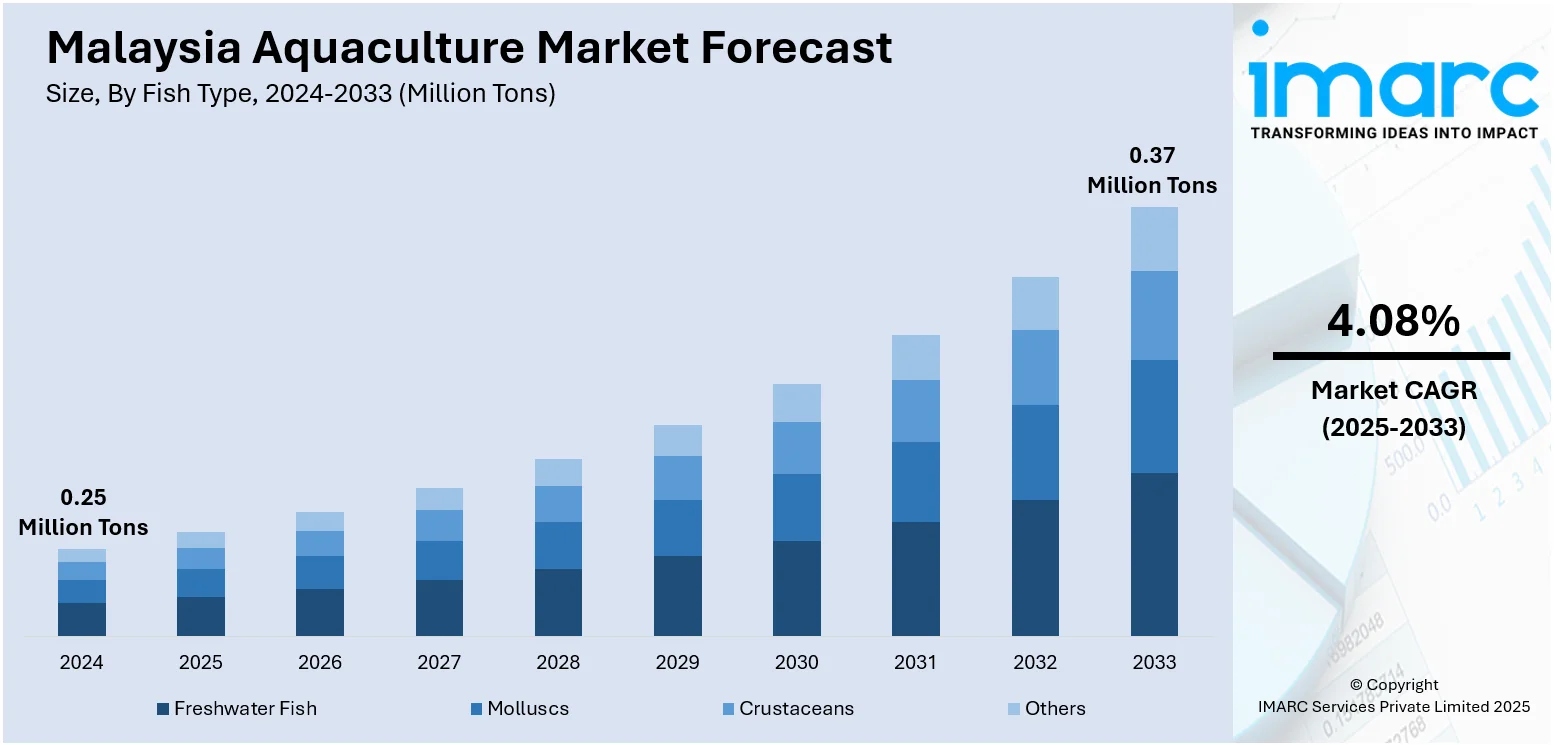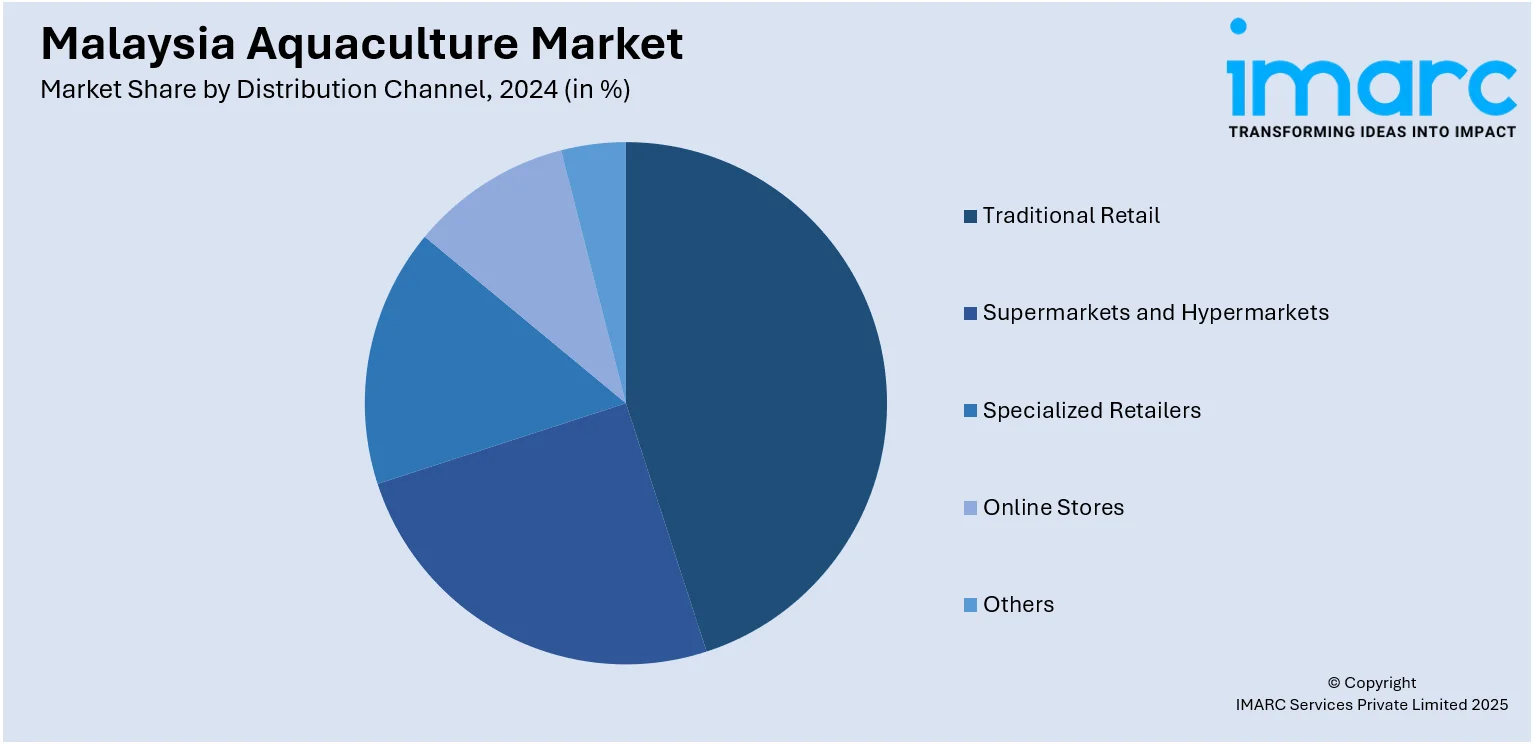
Malaysia Aquaculture Market Size, Share, Trends and Forecast by Fish Type, Environment, Distribution Channel, and Region, 2025-2033
Malaysia Aquaculture Market Overview:
The Malaysia aquaculture market size reached 0.25 Million Tons in 2024. Looking forward, the market is projected to reach 0.37 Million Tons by 2033, exhibiting a growth rate (CAGR) of 4.08% during 2025-2033. The market is driven by growing seafood consumption, export opportunities in ASEAN and China, supportive government policies, and technological modernization. Coastal geography supports diverse farming practices, while hatchery and feed improvements enhance output. These combined factors are contributing to a stronger position in the Malaysia aquaculture market share.
|
Report Attribute
|
Key Statistics
|
|---|---|
|
Base Year
|
2024
|
|
Forecast Years
|
2025-2033
|
|
Historical Years
|
2019-2024
|
| Market Size in 2024 | 0.25 Million Tons |
| Market Forecast in 2033 | 0.37 Million Tons |
| Market Growth Rate 2025-2033 | 4.08% |
Malaysia Aquaculture Market Trends:
Shrimp Farming Innovation
Shrimp farming is a major segment within the Malaysian aquaculture market, and recent innovations are transforming its productivity and sustainability. Technologies like biofloc systems and intensive pond management practices are improving yields while reducing environmental impact. For instance, in July 2025, Universiti Malaysia Terengganu’s Institute of Tropical Aquaculture and Fisheries (AKUATROP) signed research agreements with four aquaculture firms, Balavat Bayu, Entomal Biotech, Deepblue Aquaculture, and Serandu Aquaponic System, under the Ministry of Higher Education’s Industry Matching Grant (IMaP) scheme. The collaborations focus on high-impact areas such as mud crab farming, insect-based protein alternatives, catfish breeding via biofloc technology, and soft-shell crab production. These projects aim to drive sustainable innovations, bolster sector competitiveness, and facilitate technology transfer between academia and industry. Local startups and academic institutions are collaborating to develop disease-resistant shrimp strains and cost-effective probiotics. Additionally, the Ministry of Agriculture is supporting modern hatcheries to reduce dependency on imported post-larvae. Export markets such as China and Japan demand high-quality shrimp, prompting farmers to adopt traceability and food safety certifications. These advancements in shrimp aquaculture are enhancing competitiveness and are a key driver of Malaysia aquaculture market growth, particularly in states like Selangor, Sabah, and Johor.

To get more information on this market, Request Sample
Focus on Sustainable Certifications
Malaysia’s aquaculture producers are increasingly pursuing international sustainability certifications such as Aquaculture Stewardship Council (ASC), GlobalG.A.P., and MyGAP (Malaysia’s Good Agricultural Practices). This trend is driven by demand from premium export markets and local supermarkets. Certified farms must adhere to stringent standards in feed use, waste management, and labor practices. For instance, Sankina Aquaculture became Malaysia’s first ASC-certified shrimp farm recently. Located in Sabah, the farm emphasizes sustainability through mangrove restoration, antibiotic-free farming, and innovative technologies like AI monitoring and genetic sequencing. Several producers are integrating these certifications into their branding strategies to capture value-added markets. Support from international development agencies and government grants is making certification more accessible for smallholders. As certified seafood becomes a market differentiator, this trend is expected to significantly influence Malaysia aquaculture market growth by promoting responsible and competitive practices across the supply chain.
Malaysia Aquaculture Market Segmentation:
IMARC Group provides an analysis of the key trends in each segment of the market, along with forecasts at the region/country level for 2025-2033. Our report has categorized the market based on fish type, environment, and distribution channel.
Fish Type Insights:
- Freshwater Fish
- Molluscs
- Crustaceans
- Others
The report has provided a detailed breakup and analysis of the market based on the fish type. This includes freshwater fish, molluscs, crustaceans, and others.
Environment Insights:
- Fresh Water
- Marine Water
- Brackish Water
A detailed breakup and analysis of the market based on the environment have also been provided in the report. This includes fresh water, marine water, and brackish water.
Distribution Channel Insights:

- Traditional Retail
- Supermarkets and Hypermarkets
- Specialized Retailers
- Online Stores
- Others
The report has provided a detailed breakup and analysis of the market based on the distribution channel. This includes traditional retail, supermarkets and hypermarkets, specialized retailers, online stores, and others.
Regional Insights:
- Selangor
- W.P. Kuala Lumpur
- Johor
- Sarawak
- Others
The report has also provided a comprehensive analysis of all the major regional markets, which include Selangor, W.P. Kuala Lumpur, Johor, Sarawak, and others.
Competitive Landscape:
The market research report has also provided a comprehensive analysis of the competitive landscape. Competitive analysis such as market structure, key player positioning, top winning strategies, competitive dashboard, and company evaluation quadrant has been covered in the report. Also, detailed profiles of all major companies have been provided.
Malaysia Aquaculture Market News:
- In July 2024, Fujian Straits Planning Institute and Hua Min Digital Intelligence Technology Co. partnered with Malaysia’s Kedah state to develop the Kedah State Marine and Fisheries Economic Zone. The CNY 1.2 billion project includes port infrastructure, aquaculture facilities, and cold chain systems. Supported by Malaysia Ao Xin Port Development Co., the initiative aims to boost sustainable seafood production using Chinese aquaculture technology. It aligns with Malaysia’s focus on certified, export-ready aquaculture, enhancing its global competitiveness and advancing regional food security goals.
Malaysia Aquaculture Market Report Coverage:
| Report Features | Details |
|---|---|
| Base Year of the Analysis | 2024 |
| Historical Period | 2019-2024 |
| Forecast Period | 2025-2033 |
| Units | Million Tons |
| Scope of the Report |
Exploration of Historical Trends and Market Outlook, Industry Catalysts and Challenges, Segment-Wise Historical and Future Market Assessment:
|
| Fish Types Covered | Freshwater Fish, Molluscs, Crustaceans, Others |
| Environments Covered | Fresh Water, Marine Water, Brackish Water |
| Distribution Channels Covered | Traditional Retail, Supermarkets and Hypermarkets, Specialized Retailers, Online Stores, Others |
| Regions Covered | Selangor, W.P. Kuala Lumpur, Johor, Sarawak, Others |
| Customization Scope | 10% Free Customization |
| Post-Sale Analyst Support | 10-12 Weeks |
| Delivery Format | PDF and Excel through Email (We can also provide the editable version of the report in PPT/Word format on special request) |
Key Questions Answered in This Report:
- How has the Malaysia aquaculture market performed so far and how will it perform in the coming years?
- What is the breakup of the Malaysia aquaculture market on the basis of fish type?
- What is the breakup of the Malaysia aquaculture market on the basis of environment?
- What is the breakup of the Malaysia aquaculture market on the basis of distribution channel?
- What is the breakup of the Malaysia aquaculture market on the basis of region?
- What are the various stages in the value chain of the Malaysia aquaculture market?
- What are the key driving factors and challenges in the Malaysia aquaculture market?
- What is the structure of the Malaysia aquaculture market and who are the key players?
- What is the degree of competition in the Malaysia aquaculture market?
Key Benefits for Stakeholders:
- IMARC’s industry report offers a comprehensive quantitative analysis of various market segments, historical and current market trends, market forecasts, and dynamics of the Malaysia aquaculture market from 2019-2033.
- The research report provides the latest information on the market drivers, challenges, and opportunities in the Malaysia aquaculture market.
- Porter's five forces analysis assist stakeholders in assessing the impact of new entrants, competitive rivalry, supplier power, buyer power, and the threat of substitution. It helps stakeholders to analyze the level of competition within the Malaysia aquaculture industry and its attractiveness.
- Competitive landscape allows stakeholders to understand their competitive environment and provides an insight into the current positions of key players in the market.
Need more help?
- Speak to our experienced analysts for insights on the current market scenarios.
- Include additional segments and countries to customize the report as per your requirement.
- Gain an unparalleled competitive advantage in your domain by understanding how to utilize the report and positively impacting your operations and revenue.
- For further assistance, please connect with our analysts.
 Request Customization
Request Customization
 Speak to an Analyst
Speak to an Analyst
 Request Brochure
Request Brochure
 Inquire Before Buying
Inquire Before Buying




.webp)




.webp)












